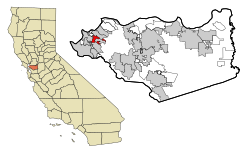El Sobrante
| El Sobrante | |
|---|---|
| Census-designated place | |

San Pablo Dam Road looking eastward through El Sobrante.
|
|
 Location in Contra Costa County and the state of California |
|
| Location in the United States | |
| Coordinates: 37°58′38″N 122°17′43″W / 37.97722°N 122.29528°WCoordinates: 37°58′38″N 122°17′43″W / 37.97722°N 122.29528°W | |
| Country |
|
| State |
|
| County | Contra Costa |
| Government | |
| • State Senate | Nancy Skinner (D) |
| • State Assembly | Tony Thurmond (D) |
| • U. S. Congress | Mark DeSaulnier (D) |
| Area | |
| • Total | 2.765 sq mi (7.162 km2) |
| • Land | 2.765 sq mi (7.162 km2) |
| • Water | 0 sq mi (0 km2) 0% |
| Elevation | 187 ft (57 m) |
| Population (2010) | |
| • Total | 12,669 |
| • Density | 4,600/sq mi (1,800/km2) |
| Time zone | PST (UTC-8) |
| • Summer (DST) | PDT (UTC-7) |
| ZIP codes | 94803, 94820 |
| Area code(s) | 510 |
| FIPS code | 06-22454 |
| GNIS feature IDs | 1658484, 2408062 |
El Sobrante (Spanish for "surplus" or "remaining land"; Spanish: [el so.ˈβran.te]) is a census-designated place (CDP) in Contra Costa County, California, United States. The population was 12,669 at the 2010 census.
According to the United States Census Bureau, the CDP has a total area of 2.8 square miles (7 km2), all of it land.
El Sobrante is unincorporated and lies within Contra Costa County. Main roads include San Pablo Dam Road (a major road running from Richmond and San Pablo, through El Sobrante, past EBMUD's San Pablo Reservoir), Valley View Road and Appian Way. San Pablo Dam Road and Appian Way both connect to Interstate 80 to the west.
El Sobrante also contains San Pablo Creek, running behind the library, ACE hardware store and many homes.
Between 5000 and 1000 BC, an indigenous tribe of people called the Huichin, an Ohlone people, came to the East Bay, including El Sobrante. One of the Huichin villages was located where the El Sobrante Library now stands. The Huichin left a now-buried shell mound beside San Pablo Creek.
Between November 1794 and May 1795, the Huichin were forcibly converted to Christianity by Spanish missionaries. After all of the Huichin were removed to Mission San Francisco, they suffered an epidemic of European diseases as well as food shortages, and died in great numbers, resulting in alarming statistics of death and escapes from the missions. In pursuing the runaways, the Franciscans sent neophytes first and (as a last resort) soldiers to go round up the runaway "Christians" from their relatives, and bring them back to the missions. Thus illness spread both inside and outside of the missions.
...
Wikipedia

